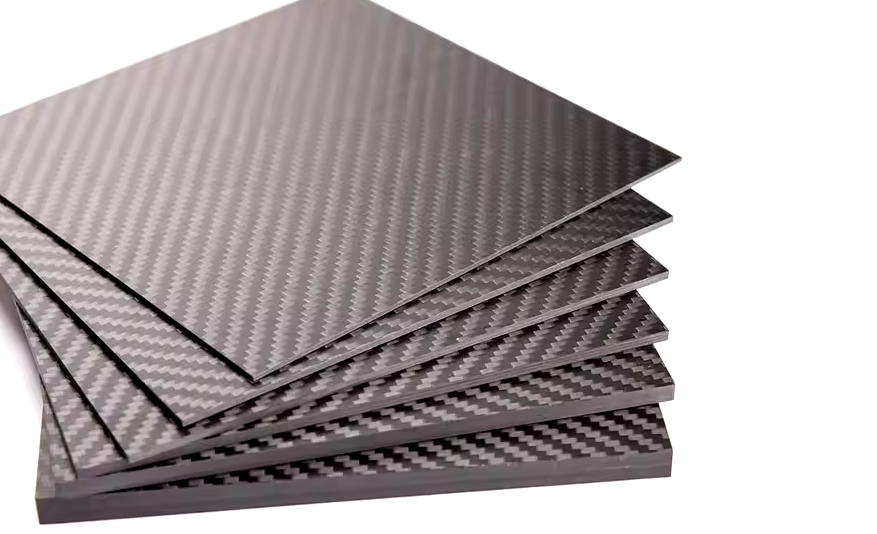Carbon fiber sheets are revolutionizing the aerospace industry, offering unmatched strength-to-weight ratios, durability, and design flexibility that are crucial for modern aviation. Due to these properties, carbon fiber has become an indispensable material in the development of both commercial and military aircraft, spacecraft, and satellites. In this article, we’ll explore the top applications of carbon fiber sheets in aerospace engineering and highlight how they are transforming the way aircraft and spacecraft are built and operated.

1. Aircraft Structural Components
One of the most significant applications of carbon fiber sheets in aerospace engineering is in the production of aircraft structural components. These include parts like wings, fuselages, tail sections, and control surfaces (such as rudders and ailerons). Carbon fiber's high strength-to-weight ratio makes it ideal for components that must bear significant stress while remaining as light as possible.
For example, modern commercial airliners such as the Boeing 787 Dreamliner and the Airbus A350 make extensive use of carbon fiber composite materials in their fuselage and wing structures. By replacing traditional materials like aluminum with carbon fiber, manufacturers can reduce the overall weight of the aircraft, leading to better fuel efficiency, improved performance, and reduced operational costs. Lighter weight also contributes to better maneuverability and overall flight efficiency, which is a critical factor for both commercial and military aviation.
2. Aircraft Interior Parts
In addition to structural components, carbon fiber sheets are also used in the production of aircraft interior parts. The lightweight and strong properties of carbon fiber make it an ideal material for non-structural components that need to withstand significant wear and tear while contributing to reducing the overall weight of the aircraft. These interior parts can include:
- Seats
- Cabin walls and ceilings
- Cargo holds
- Partition panels
Using carbon fiber for these components reduces weight without sacrificing strength or safety, resulting in more comfortable and efficient passenger aircraft. Carbon fiber's aesthetic appeal also lends itself to luxury and premium class interiors, where sleek and modern design is desired.
3. Engine Components
Carbon fiber sheets are increasingly being used in the production of aircraft engine components, particularly in turbine blades, compressor blades, and engine casings. The material’s ability to withstand high temperatures while remaining lightweight makes it ideal for these high-performance components, where every ounce of weight reduction contributes to greater fuel efficiency.
In modern jet engines, carbon fiber components can endure extreme heat and pressure conditions, allowing for improved engine performance, reduced fuel consumption, and lower emissions. The use of carbon fiber also contributes to the reduction of engine noise, a key consideration for both commercial and military aircraft.
4. Satellite and Spacecraft Construction
Carbon fiber sheets are critical in satellite and spacecraft construction, where weight savings are even more crucial due to the high cost of launching materials into space. The combination of carbon fiber’s low weight and high strength makes it an ideal material for spacecraft structures, satellite frames, and solar panel supports.
For instance, carbon fiber composite materials are often used to build lightweight, durable satellite structures that can withstand the harsh conditions of space. These materials not only reduce the weight of the satellite but also increase its ability to handle the thermal expansion and contraction caused by extreme temperature variations in space. Additionally, the high strength of carbon fiber helps ensure that spacecraft can endure the stress of launch and travel through space without compromising structural integrity.
Carbon fiber is also commonly used in spacecraft thermal protection systems, where its ability to handle extreme temperatures (both hot and cold) plays a crucial role in protecting satellites and spacecraft from environmental hazards in space.
5. Flight Control Systems
Flight control systems, such as elevator assemblies, rudders, flaps, and elevators, are subject to high aerodynamic forces and are crucial for the stability and maneuverability of the aircraft. Carbon fiber sheets, due to their ability to be engineered to specific stiffness and strength requirements, are ideal for these components.
Carbon fiber composites are not only lightweight and strong but also highly resistant to corrosion, which is essential for flight control systems that operate in environments exposed to moisture and extreme temperatures. The use of carbon fiber enhances the precision and responsiveness of the flight control systems, improving overall flight safety.
6. Landing Gear Components
Landing gear is another area where carbon fiber sheets are increasingly being used. The carbon fiber composite materials in landing gear components such as struts, brackets, and doors help reduce weight while maintaining the strength and durability needed to support the full weight of the aircraft during takeoff, landing, and taxiing.
With the adoption of carbon fiber in landing gear, airlines can benefit from reduced fuel consumption and lower operational costs, as lighter landing gear reduces the overall weight of the aircraft. Moreover, the corrosion resistance of carbon fiber ensures longer-lasting and more reliable performance in the highly demanding conditions landing gear is subjected to.
7. Aircraft Fuel Tanks
Another growing application of carbon fiber in aerospace engineering is the use of composite materials (including carbon fiber) for aircraft fuel tanks. Carbon fiber fuel tanks are not only lighter than traditional metal tanks but are also more resistant to leaks and damage from impacts.
For example, some modern aircraft, such as the Boeing 787 Dreamliner, incorporate composite fuel tanks made of carbon fiber to reduce the aircraft's weight and increase fuel efficiency. These tanks also enhance safety by providing a more resilient structure that can better withstand external impacts and internal pressure variations, ensuring more reliable fuel containment.
8. Landing Gear Doors and Fairings
Landing gear doors and fairings are essential parts of an aircraft’s aerodynamics and structural design. These parts help improve the flow of air over the aircraft, reduce drag, and protect sensitive systems. Carbon fiber’s low weight and ability to be molded into precise shapes make it an ideal material for manufacturing these components.
By using carbon fiber in landing gear doors and fairings, aerospace manufacturers can achieve better aerodynamic performance and lower fuel consumption. Additionally, the material’s durability ensures that these components can withstand the stress of frequent takeoffs and landings, all while being corrosion-resistant.
Conclusion
Carbon fiber sheets are playing an increasingly pivotal role in aerospace engineering, with applications spanning aircraft structures, engine components, satellite frames, flight control systems, and more. The aerospace industry has embraced carbon fiber for its ability to offer exceptional strength, lightweight properties, corrosion resistance, and design flexibility.
As the demand for more fuel-efficient, high-performance, and environmentally friendly aviation solutions grows, carbon fiber’s role in aerospace will continue to expand. From the commercial aviation sector to cutting-edge space exploration, carbon fiber sheets are helping to shape the future of aerospace technology, making aircraft safer, more efficient, and more sustainable than ever before.













































